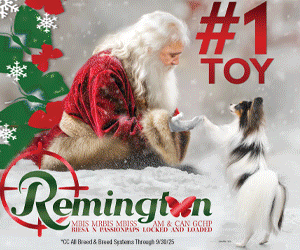Learning To Assess Young Dogs
Click here to read the complete article
146 – November/December, 2014
by William Given
Puppies and young dogs are well-known for assuming an amazing array of extraordinarily unappealing shapes and sizes before they reach any sort of fixed maturity. You may look at a very handsome and promising youngster that has a good many outstanding qualities one day, only to find a month later that he has gone completely course. You may look at another that you opt to reject because she looks as if she were a cross between a goat ant a giraffe, only to find she has turned into a beautiful swan two years later, in someone else’s kennel. Puppies and young dogs may toe in one day, out the next, be cowhocked or possess no chest whatsoever. One week they may have hindquarters measurably higher than their withers.
The next, no rear end at all and no withers either for that matter. The young dog with a swanlike neck may mature into a five-year-old with a short fat one. To make things worse, on occasion some dogs may look absolutely perfect at eight months of age, then losing all semblance of breed type by the tender age of three years. Conversely, other young dogs may totally surprise you by looking absolutely wonderful at all ages.
Some breeders maintain that the ability to pick out the good ones is innate and you either have it or you don’t. There are certainly a few blessed people in the world who seem to have an almost mystical sense of the future quality of a current catastrophe. The rest of us “mere mortals” have to study hard and learn by experience over a period of many years to find the components that should combine to make tomorrow’s grand champion, multiple group placing and Best In Show winner.
The single most important thing that will make your job easier is a solid knowledge of how other members of the same family have matured. A specific stud dog may routinely pass on a rock solid topline, for instance. A brood bitch may give the lion’s share of her offspring great reach and drive. Looking at siblings and half-siblings of the puppies and young dogs that interest you is the best way to evaluate how consistently these outstanding qualities are passed on to offspring. And, looking at relatives at different ages and stages of growth may give you a sense of how certain lines of dogs mature. If they tend to grow “all together” and the young dog you are considering has a weak topline, no chest, and bad hocks, you may be looking at the family’s token ugly duckling. If, however, this particular line is known to be notoriously slow to mature, and all the young dogs you have seen by the same sire tend to share the same lack of strong breed characteristics before becoming beautifully mature four- or five-year-olds, you could be looking at just another immature family member with truly outstanding potential.
It is universally prudent to give any young dog the benefit of a little time to grow. A puppy or young dog that already looks mature or is on the “husky” side could quite possibly grow into something that is overly heavy or course in another couple of years. Even those that develop in a steady fashion ought to be a little on the “lanky” side to provide the notion that they have something to grow into. In time, with proper care and conditioning, a gangly young dog with a solid frame has a good chance of filling out that frame.
Chests and hindquarters can broaden somewhat with age, necks can be developed, and heads and ears grown into, however, some things are going to be pretty much set in stone even in youngsters. You are going to be stuck with the shoulder angles you are looking at, and with the length of back and croup. Slight cowhocks may straighten themselves with age and proper exercise. A roach back will merely become a better-muscled roach back. You are also stuck with bad feet. The tendency toward bad feet is genetic. Bad feet will very likely be passed on to some number of the stud dog’s and brood bitch’s offspring.
In terms of fertility, a puppy or young dog will not be able to be proven as a sire or brood bitch for a couple of years. When vetting them out, the most that you can really do is to try to get a complete medical history in order to rule out any history of illness or congenital problems that might affect future fertility. A veterinary examination can ensure that the dog is completely sound and that its reproductive organs are maturing normally.
Puppies and young dogs present potential buyers with a similar set of challenges. We are all attracted to puppies that are fat, shiny and obviously well cared for. We immediately tend to write off young dogs that are overly hairy, unkempt, thin or shy and unhandled. A well-fed and well-conditioned young dog may quickly fool the observer’s eye into thinking “Wow! He is a handsome dog!” However, a second harder look may detect a variety of conformational weaknesses that may range from a long back to a straight shoulder to a less-than-characteristic head to a neck that is really not very attractive.
In a thin dog, all of these flaws are immediately evident. It is his good qualities that are harder to ascertain. For example, is his back really too long? Or is this a function of being grossly underweight? Is that a ewe neck, or simply an unmuscled one? Or what would her hindquarters look like after a few months of proper feeding and regular exercise?
The key here is to try to differentiate between those things that are the result of musculature (which can be corrected dramatically with proper feeding, care, and exercise) and those that are structural (which is largely a matter of substance). A perfect example of the latter would be the width of the chest. Width of chest is circumscribed by the degree to which the ribcage is sprung and the distance between the points of the shoulder. Although, a very thin dog may appear narrower than a fat one due to the lack of flesh covering its ribs, all the good food and exercise in the world will not broaden a mature dog’s chest because it is limited by the skeleton.
Cowhocks and a long back are also structural, but extra weight can make a back appear shorter, and the muscling that comes from regular exercise can improve the appearance of both hocks and hindquarters. It will not make them go away nor will it make these undesirable traits less heritable.
An overweight dog, on the other hand, can mask what could turn out to be a perfectly adequate shoulder angle and whither. At least the thin dog will show you what you have got in the structural sense as too much fat can obscure some good qualities, as well as a myriad of faults.
Trying to add or subtract weight mentally as you look at these dogs, and imagining them at work or properly groomed, is not always easy when the puppy or young dog is standing in front of you. For example, I had a colleague who received a big surprise at a local show. He had purchased a young bitch with an outstanding pedigree and a great deal of potential. He had spent many months taking her to conformation classes and worked tirelessly to reduce her bulk. Now that she was slimmed down, well-conditioned and properly groomed, she really had become a very striking show dog. He had gotten used to thinking of her as his dumpling and had not truly noticed the profound changes she had undergone until she was in the show environment. She went on to become a very successful bitch in the conformation ring; she turned out to be an average performer in the whelping box.
The help of a highly experienced mentor with an ability to pick puppies and young dogs in the rough and turn them into highly respectable show dogs is immensely valuable. This person will be able to explain to you why a specific dog that might look utterly hopeless to the casual eye has the potential to develop into something really quite special, while one you believe to be a nine on a ten point scale should be passed over. With time, experience, and practice, your own eye will become more attuned to what exists beneath an ungroomed coat, ten extra pounds or a case of obvious malnutrition, or even what potential might reside within the body of the ugliest puppy or young dog you have ever laid your eyes on.
Short URL: http://caninechronicle.com/?p=64313
Comments are closed












